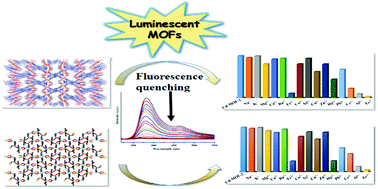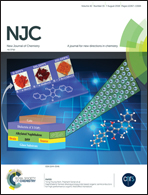Two azo-functionalized luminescent 3D Cd(ii) MOFs for highly selective detection of Fe3+ and Al3+†
Abstract
Two cadmium-based 3D luminescent MOFs {[Cd2(SA)2(L)2]·H2O}n (Cd-MOF-1) and [Cd(CDC)(L)]n (Cd-MOF-2) (H2SA = succinic acid, H2CDC = 1,4-cyclohexanedicarboxylic acid, L = [3,3′-azobis(pyridine)]) have been assembled by employing organic dicarboxylic acid linkers with an unexploited azo-functionalized N,N′ spacer via a room temperature slow evaporation process, and they are characterized by single crystal X-ray analysis, TGA, FT-IR, PXRD and elemental analysis. The topological analysis reveals that Cd-MOF-1 features a 6c-uninodal rare ‘rob’ topology with the point symbol {48·66·8}, whereas Cd-MOF-2 shows a ‘pcu’ alpha-Po primitive cubic topology with the point symbol {412·63}. These MOFs are highly emissive at 382 nm and 398 nm when excited at 305 nm and 312 nm, respectively. The exposed azo groups are presumed to act as functional sites for the recognition of metal ions through quenching of fluorescence intensity. The fluorescence measurements show that these MOFs can selectively and sensitively detect Fe3+ as well as Al3+ and thus, they demonstrate potential as dual-responsive luminescent probes for metal-ion sensing. EDS elemental mapping, PXRD of loaded MOF materials, and a plausible quenching mechanism have been discussed. More importantly, both the MOFs exhibit rapid response times toward sensing of Fe3+ and Al3+.



 Please wait while we load your content...
Please wait while we load your content...